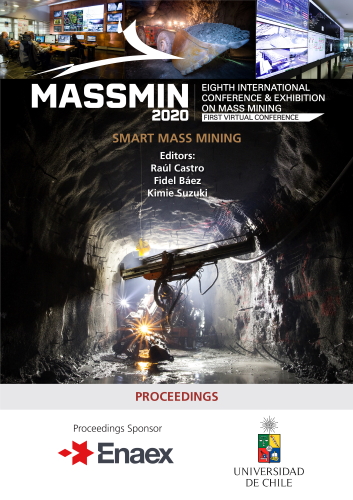Design and production practice of block caving in Pulang Copper mine

|
Authors: YuMing, L; Chen, XW; Feng, XL; Ge, QF |
This paper is hosted with the kind permission of Lulea University of Technology, International Conference & Exhibition on Mass Mining, 2024.
DOI https://doi.org/10.36487/ACG_repo/2063_50
Cite As:
YuMing, L, Chen, XW, Feng, XL & Ge, QF 2020, 'Design and production practice of block caving in Pulang Copper mine', in R Castro, F Báez & K Suzuki (eds), MassMin 2020: Proceedings of the Eighth International Conference & Exhibition on Mass Mining, University of Chile, Santiago, pp. 736-746, https://doi.org/10.36487/ACG_repo/2063_50
Abstract:
With a design ore production capacity of 12.5 million tonnes per year, the Pulang copper mine is China’s second largest block caving mine. It is located 63 km northeast of the city of Shangri-La in Yunnan Province. The orebody outcrop has an altitude of 3,868-4,023 metres above sea level (masl) and its bottom is below 3,500 masl. As a porphyry copper deposit, it is ideal for open-pit mining but, for environmental reasons, can only be mined from underground. Moreover, due to its low ore grade, only block caving is economical. The production level is set at the 3,720 m level. Due to the orebody’s thickness and size, it is divided into three mining areas: the central, southern and northern areas. The central area, which has a relatively higher copper grade and offers greater early-stage economic benefit, was selected as the first mining block with a footprint of 500 m × 330 m and a mining column height in the range of 85-295 m. The ore passes are arranged within the panel. Under its advance undercut strategy, undercutting advances from the centre of the first mining area to both its ends in parallel. Long-hole drill rigs are used for undercut drilling and 14-tonne electric LHD loaders for ore extraction. To tow the 20-m3 tramcars for ore haulage, 65-tonne electric locomotives are used. The ore is crushed underground before being transported to the concentrator by a 3,064-m belt conveyor in a tunnel. The mine started trial production in March 2017 and ore production capacity has so far reached 30,000 tpd. Cave propagation is smooth and has connected through to the ground surface. As of March 2019, the surface subsidence zone measured 85,000 m2. This paper briefly describes the mine’s geotechnical engineering, design scheme, production practices and current problems.
References:
Chen, X, Liu Y, Ge, Q & Li, S 2015, ‘Application of PC-BC software in Block Caving Method’, China Mine Engineering, vol. 44, no. 5, pp. 18-20.
Fan, W, Liu, Y & Ge, Q 2017, ‘Study on Bottom Structure Stability in the Undercutting Process of Block Caving’, China Mine Engineering, vol. 46, no. 1, pp. 1-4.
Li, S, Chen, X & Liu, Y 2017, ‘Research and Development of Ore Drawing Management System for Block Caving Method’, Modern Mining, no. 2, pp. 72-77.
Liang, J, Liu, H & Feng, X 2017, ‘Numerical Simulation Study on Advanced Undercutting in Block Caving method’, Mining R&D, vol. 37, no. 2, pp. 93-96.
Liu, YM & Bian, KW 2016, ‘Production at Lift 530m of Tongkuangyu Copper Mine’, in proceedings of the Seventh International Conference and Exhibition on Mass Mining, Massmin 2016, Sydney, pp. 385-391.
Liu, Y & Zheng, J 2008, ‘Tongkuangyu mine’s phase 2 project’, in H Schunnesson, E Nordlund (eds), Proceedings of MassMin 2008, Lulea, Sweden, pp. 53-61.
Samosir, E, Basuni, J, Widijanto, E & Syaifullah, T 2008, ‘The management of wet muck at PT Freeport Indonesia’s Deep Ore Zone Mine’, in proceedings of the Fifth International Conference and Exhibition on Mass Mining, Massmin 2008, Lulea, pp. 323-332.
© Copyright 2025, Australian Centre for Geomechanics (ACG), The University of Western Australia. All rights reserved.
View copyright/legal information
Please direct any queries or error reports to repository-acg@uwa.edu.au
View copyright/legal information
Please direct any queries or error reports to repository-acg@uwa.edu.au
